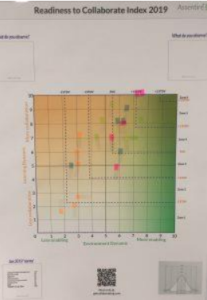
Jun 14, 2021 | News and insight
Contact us to find out more about the different roles that are available.
If you are a specialist in organisational and project culture, change and transition management, collaborative working or leadership development and want to develop those skills further working on complex projects, we’d love to hear from you.

Jun 7, 2021 | News and insight
According to Lee Howell, the World Economic Forum’s Global Head of Programming, the leaders at DAVOS need to be in “active listening mode”.
“People come to the annual meeting and they have their institutional mandate and goals they seek,” Howell said. “But they need to be less in speaking mode and more in listening mode. It’s really an exercise in active listening — to understand what the Chinese might be saying on ‘X’ topic, or what the French feel about ‘Y’ topic…The chance of a more resilient and robust solution stems from that.”
Have you ever heard of Active Listening? Well, it might just transform your conversations, develop your presence as a leader and help your team collaborate more effectively. It sounds like a critical leadership skill that we cannot ignore!
So, what is active listening and how does it improve the chances of the “more resilient and robust solution” that Howell desires?
In this 2-part article, I will endeavour to explain traditional listening – or how we listen when we don’t think about it – (part 1) and active listening – how we can listen when we do think about it (part 2).
Part 1: Traditional Listening
Howell’s comment could extend to any type of meeting or conversation. From a speaker in front of a group to team meetings to one-to-one conversations, if you looked closely at the speaker and listener roles, you might notice that people tend to fall into certain expected behaviours. The conversation is speaker focused and speaker driven – they hold the power. The listener is (generally!) focused on the speaker, picking up clues in language and visuals to help define and understand the overall message. Often, the overall effect, though, is one of the listener being a bit-player; deadpan, motionless, there to be entertained or fed information. We’ve all been in meetings or had conversations where we’ve just sat back and let the words drift over us in a haze.
As listeners, we leave little opportunity to think about how our listening is perceived by the speaker.
When the speaker faces a passive listener, it’s not surprising that they have no idea what you are thinking – are you really interested? Bored? Away with the fairies? Stephen Covey (author of The 7 Habits of Highly Effective People) says that “next to physical survival, the greatest need of a human being is psychological survival – to be understood, to be affirmed, to be validated, to be appreciated.” If a listener is not giving the speaker that psychological well-being, what do they do? I have felt the need to ask the audience:
- Am I being clear?
- Are you with me so far?
- Does that make sense?
A hunt for feedback from the listener. And how do you respond to the speaker in return – a weak smile, a small nod of the head, a quick change of posture? A minimal gesture of feedback. More often than not, especially in larger groups, the speaker is faced with a sea of blank stares.
How do you communicate to the speaker that you are listening?
Are we so used to technology, screen time that requires no visual or verbal feedback, that we have grown to assume that any feedback is an infringement on the speakers right to be heard, as a breach of politeness or an unwarranted interruption? Even if we are committed to listening intently, we soon run out of focus power. When losing concentration, our mind wanders, distraction and bias enter, and our conversation becomes at a distance.
For all the speaker knows, you could be:
- In the wrong time zone – stuck back on a comment made 15 minutes ago or speeding ahead of the speaker in fast-forward mode.
- Distracted – why hasn’t the speaker had surgery to remove the humongous mole on the side of their chin?
- Ignoring them – I know all this already; why am I even in this meeting?
Or distracted by any one of a number of emotional, physical, cognitive beliefs, biases, thoughts and filters. All can wreak havoc on our ability to listen. I believe the average listener operates under two principles:
- Taking the path of least effort
- The topic must interest you
As listeners, we want only the relevant information, readily available and beautifully packaged, delivered to our door and right now. Only, when it comes to everyday conversations, we rarely get it that way. It’s hard work to figure out the main points from the fluff. It’s hard work to get past the accent and the funny shirt. It’s hard work to figure out the real intent behind the words.
But if you don’t do this, it’s not really a good conversation, is it?
It is time to challenge the traditional listener role and think about our listening in a more strategic manner. As an industry, we can’t keep talking about collaboration and improved quality of stakeholder relationships without adjusting our role as listeners.
We need to think of listening as a form of engagement, not a form of solitude.
We need to start thinking about listening with strategy, empathy, and the speaker’s needs in mind. Why? Because active listening can leverage higher levels of understanding and rapport. Feedback to the speaker can greatly enhance their confidence, their assertiveness and their openness. And that feedback will simultaneously allow you as the listener to focus better – it is a major element in concentration control.
So how about we give it a try?
Part 2: Active Listening
The benefits:
- Deepen your conversations
- Develop your presence as a leader
- Help your team collaborate more effectively
Sounds good, doesn’t it?
We often hear about how to improve our speaking skills but rarely talk about our ability to listen well. If we want to talk about collaboration, we need to raise our self-awareness about our listening and think about how to have better conversations.
I’m going to describe active listening as a series of stages. Depending on our needs and the situation, we travel back and forth through the stages, perhaps without much thought. But, the more practice you have at active listening, the more self-awareness you’ll have of which stage you are in and how to shift it to be more impactful.
- Self
For the most part, we need to take care of our own needs first, and this is centred around information gathering, for example, a meeting at work. You check that you’ve got the right printouts, that your phone is on silent, and you wonder, “what’s in it for me?”, “What is my role in this meeting?”, “What could I achieve?”, “What do I need to do before I can be fully present?”
- Focus
Put away the phone, stop thinking about the last meeting or worrying about the next deadline and be 100% present. This way we can bring that awareness outside of ourselves and direct it towards the speaker.
“What could this person teach me?”
“What does the organiser wish the outcome of this meeting to be?”
We show that we are listening by orientating ourselves towards the speaker and making eye contact. The trouble is, we can’t sustain this for long and lose our focus easily. We start thinking about lunch, start doodling in our notebook and slouch back in the chair. The average person talks at about 225 words per minute, but we can listen to up to 500 words per minute. Our minds love to fill in those other 275 words! No one is immune to thoughts creeping in, and we must let them go, bringing ourselves back to 100% focus.
- Response-ability
As listeners, we are not really defined by the message we receive, but how we react to it, and our focus can easily turn into judgement, reaction and rebuttal. By setting aside our own agenda, we can, instead, become curious. This is especially important for those who think they have little value to offer or don’t know anything about the subject. A shift from “will I be wasting my time here?” to “what could I learn from this conversation?” will increase your presence in the room immediately.
The hardest part of active listening involves the suspension of self-needs; that is your burning desire to deliver your opinion, your advice, and your solution! Instead, be prepared to stay with the unknown. Listen to assess the meaning or intent behind the words; the body language, the tone of voice, the pace of the dialogue. Listen for energy, emotion, values; what makes the speaker come alive and what makes them shrink back? You may also have information about the group, the wider system and the culture to keep in mind too. Don’t forget to use your intuition and senses. Even the environment around you is giving you information above and beyond the direct message.
“In response to this information, what options do I have?”
As listeners, you have a right, if not an obligation, to let the speaker know how much of the message you have received and its effect on you (the speaker can let you do this by offering up an occasional pause!). But what information do we respond to? How will we respond? What impact will it have on the speaker? We might worry that any response we give will be seen as an interruption or viewed as impolite. Knowing how to respond is one thing but knowing when to respond is another. This takes courage as well as tact.
“What response will my feedback elicit?”
“Will my response forward the speaker’s thinking?”
- Feedback
Giving feedback is a great antidote to a lack of focus! When you give the speaker more feedback, you do several things:
- You will be able to concentrate for longer and you will remember more,
- You will feel more involved,
- The speaker will feel safer.
It’s a win-win situation. Your feedback provides ‘psychological safety’ and validation to the speaker – these are two basic human needs and are intrinsic to creating trust. When feeling safe, the speaker will be more inclined to dive deeper into the conversation and are more likely to express themselves more authentically and fully. If you want a better conversation, then it is your job as the listener to help the speaker feel safe – an act of inclusion.
At a basic level, we give the speaker feedback with behaviour: a nod of our head, changes in posture and making eye contact or verbally. The speaker, though, can’t always read the intent behind an “mmmm”, so we must step it up!
Clarity and concreteness – Ask open-ended questions to help obtain more specific information e.g., “You mentioned this point as crucial – can you explain further?
Summarise – Clarify the speaker’s point by articulating your understanding of what is being said e.g., “Are you saying that Clara will be the only point of contact for the project team?”
Empathy – Make an effort to show that you understand what the speaker’s issue is e.g., “I can understand, after all your late nights, why you would be angry about this latest design change.”
Confront in a neutral manner – Expand the speaker’s perspective or shift attention by noticing and pointing out discrepancies in what is being said versus what is being done. Mirror back to the speaker, patterns and themes e.g., “I notice that you are agreeing with me but also grunting in reluctance – can you see something that I can’t?”
We are effectively shifting the power from the speaker into a more collaborative zone where both the listener and speaker are contributors to the conversation. The listener is not a passive receptacle for information but an active participant in enabling the speaker to dive deeper. Giving feedback signifies our commitment to the conversation.
On the whole, travelling through these stages requires thoughtfulness, reflection and respect. If you can remain focused on the speaker, suspending your own needs or agenda, you can advance the speaker’s thinking further:
- Remain silent and give them the space to think
- Give them respect by holding the belief that this person is capable of resolving issues on their own
- Remain emotionally stable and neutral
- Allow the speaker to vent without judgment
- Build on their ideas and suggestions
With self-awareness and regular practice, we can all appreciate a higher level of listening quality. The success of leaders hinges not only on speaking well but on the ability to listen attentively and to respond appropriately.
An active listener maintains focus and listens with deliberate intent, whilst the traditional listener is fixated on themselves.
An active listener curbs the urge to take over and keeps the attention on the speaker.
When we learn to blend focus and feedback as both participant and collaborators, then our conversations become more open to genuinely expressed feelings and emotions. The speaker and listener become more at ease with each other, and our conversations are elevated.
The next time you have a conversation, base your listening on strategy, not reaction.
Karen Fugle
Karen is an Executive Coach (Personal and Business Coaching Level 7) with over 20 years in the Architectural, Engineering & Construction industries. She is a Professional Certified Coach with the International Coach Federation and a certified facilitator of the LEGO® SERIOUS PLAY® method and materials.

Apr 14, 2021 | News and insight
The team at ResoLex have developed a framework for improving the performance of teams working on major projects, which leverages a number of key elements to create a significant positive impact on how large groups of people work together in a project environment. The foundation stone that underpins the model is the quality of leadership on the project.
The ResoLex model is largely built on experience in large construction projects but the behaviours of people in large work groups is broadly similar across most sectors. Industry factors inevitably have an influence, but human beings tend to rely heavily on effective leadership when faced with any major task that requires collaboration. This article looks at an example of project leadership from the Oil and Gas Industry. The underlying message is that even when it appears too late to implement, many of the key elements of the collaboration framework, considerable value can still be obtained by focusing on those that can still be applied.
My example comes from a few years ago. I moved into a role where I was accountable for a significant portfolio of global major oil and gas projects. One of these was an offshore gas compression project – a new platform to be linked by a bridge to an existing facility. The major work breakdown structure elements were:
- construction of the new supporting ‘jacket’, bridge and gas processing ‘topsides’ plant,
- the transportation and installation (T&I) using a large crane barge of the jacket and topsides,
- delivery of three self-contained gas turbine driven compression modules and,
- ‘brownfield’ modifications to the existing facilities.
The project had just achieved Final Investment Decision (FID) and was about to enter detailed engineering, procurement and construction (EPC). The project had experienced a particularly rough road in getting to this point, having changed out the main EPC contractor and suffered significant schedule compression due to delays in reaching commercial gas sales agreements. To make matters worse, the anticipated cost of the project increased just prior to FID, coincident with a new highly transactional director from the EPC firm being engaged to ‘close the deal’. Needless to say, this severely eroded trust on all sides and morale fell to an all-time low. Not an ideal starting point I think you will agree!
The project was setting itself up to be an early train wreck. I sat with my Project General Manager (PGM) and his senior team to work out how we could reset the project. It was clear that if we were to collectively achieve some very tough targets, we needed to create a step change in culture – in short, we had to create alignment of beliefs and a shared mindset across all the organizations involved.
I recognized that a leader’s ability to influence a team’s behaviour is strongest in the first few weeks of a project. Being the responsible Vice President in the client organization, I looked outside of the industry for ideas. I then reached out to the parent contractor organizations to quickly establish a cadre of four executive level project sponsors. We had dinner and agreed that none of wanted this project to go the same way we had seen many before, developing a highly siloed ‘us and them’ culture in which a successful project outcome was secondary to transactional commercial gain through variation orders, etc. We made a commitment to ensure we were jointly successful. The discussion moved on to the obvious early challenge of bringing diverse groups together in a way in which they could work successfully on their own element of the project but critically, also support the outputs of the other small teams in which they must interact. In other words, ‘normal’ is providing assistance to other teams without demanding immediate reward. We concluded with recognizing the importance of ‘tone from the top’ – the output from this initial ‘meeting of equals’. Typically, project sponsors only meet when issues have reached an impasse at the project leadership level. Instead, we agreed to meet quarterly, whether we needed to or not to review the collaborative culture and jointly agree on how to diminish the effect of the inevitable ‘blockers’.
This public stating of the aligning narrative – this is the situation, what has to go right for the project to succeed, we can only succeed if we collaborate, this is how it is going to work – together with the visible executive level commitment, proved highly successful. The greatest value of inter-team understanding comes when teams know enough about each other to be able to provide support under pressure, and to quickly solve problems using a wider knowledge base. A few examples are as follows:
- The project teams from the different organizations were co-located to rapidly create relationships and trust.
- The T&I contractor is typically only engaged once the design is fixed (and weights and centres of gravity are known). By this stage it is too late for the T&I contractor to optimize the design resulting in late changes. Instead, we brought the T&I contractor in at the start of detailed facilities design. The early dialogue between the two organizations surfaced numerous cost and schedule saving opportunities, such as the benefit of early selection of the transportation barge and a split installation of the jacket and topsides (this came to light in a ’cross – silo’ water cooler conversation, where it was shared that the expensive crane barge would be in the location working for another client and if we could accelerate construction of the jacket we could considerably reduce mobilization costs).
- Building in advanced digitally enabled remote condition monitoring of the compression modules opened the door to a new form of servitization agreement not previously used in the offshore oil and gas industry. This required changes to the topsides controls and communications systems but, identified early, these proved relatively easy to accommodate.
- The client supported the EPC contractors with trialling new digitalized workflow methods and the creation of a full digital twin, with all associated benefits across the asset lifecycle.
From a leadership perspective, three pieces of learning have stayed with me.
Firstly, you do not need to implement the full ‘collaboration handbook’ to gain significant value from embedding a collaborative approach – even in a project that had a contracting strategy that seemed to actively preclude collaboration. Secondly, it is not sufficient to just find a good idea outside of your industry. It is necessary to first condition it to reflect the context, the custom and practice, of the receiving culture. The final act of leadership is to visibly champion its embedment, pushing back on the inevitable ‘organizational antibodies’ to allow the new practice to be proven and ultimately become part of the receiving organizations DNA. Finally, I have come to recognise there is a third dimension to risk. We naturally focus on commercial and technical risks, but we also need to integrate these with behavioural risks, appreciating of course, that risks are both threats and opportunities.
Adrian J Luckins B.Sc.(Eng), MBA, FIChemE, CEng, PMP
Adrian gained his first-hand experience through 35 years of upstream oil and gas engineering, project management, operations, and leadership roles in domestic and international assignments with Shell, ABB and BP. He holds a B.Sc. from University College London in Chemical Engineering, an MBA in Engineering Management from City University London, is a Fellow of the Institution of Chemical Engineers and a Project Management Professional (PMP).
Adrian recently retired as a member of the BP Upstream Global Projects Organization executive leadership team with accountability for major projects in the Americas, the North Sea, and subsea systems globally. He is now an independent consultant in the energy sector.

Mar 23, 2021 | News and insight
There is a growing awareness of the impact that culture has on the success of any large group of people trying to work together. The limited research that has been done tends to focus on culture change in existing businesses, companies, or institutions. There is no blueprint for how to approach culture on a project. With people at the heart of projects, we recognise that creating the right culture is important, so how do we adapt what we know about organisations to suit the project environment?
First, we must understand the key differences between projects and organisations that impact the way the culture presents and develops. Projects are often set up as temporary organisations and have some distinct features that need to be considered when thinking about the culture. Through our experiences with project teams, we have been able to develop some foundational principles that can be applied to existing models and used to build an approach to culture that is relevant for the project environment.
Project culture or organisational culture?
It would not take too much searching to find a useful definition of organisational culture:
- a set of shared behaviours and assumptions,
- collective beliefs and attitudes,
- the written and unwritten rules of conduct,
or simply ‘the way we do things around here’.
Many decades of research and development have produced robust approaches to building and maintaining successful organisational cultures. The importance of having the right culture in an organisation is rarely disputed. The question is, how does this apply to project teams? There are key features of project teams which make them different to permanent organisations.
Project teams are intentionally finite.
A team will come together to work on a specific task over an extended period, as short as several months or as long as several years. Once the outcome is achieved and the project is complete, the team is usually disbanded, and individuals join up with others on another task or project. In a traditional long-term organisation, the vision (or outcome) for the organisation is usually aspirational, with the intention of driving corporate behaviours through connecting to personal values. Due to the task-oriented nature of projects, a project organisation naturally has a much more tangible, shorter-term outcome that is not so obviously connected to personal values. Individuals may connect to the overall goal of the project in different ways.
The project environment is often high in uncertainty, complexity, and change.
Particularly in the infrastructure delivery environment, where alongside the technical motivation, projects have social and economic drivers to deliver on, uncertainty, complexity and change are the order of the day. Characteristics such as agility and team resilience become core to the success of the team. Collaboration across traditional boundaries must happen, requiring trust, transparency and sharing of information, and speed of response and decision-making.
Within a long-term business environment that is not so changeable, though these are desirable characteristics and skills to have, the stability of the organisation is not dependent on them. The culture of the organisation – ‘the way things are done around here’, can be set and embedded over time without having to respond to constant shifts in the environment.
Project teams are usually made up of people from multiple organisations.
This seems like an obvious point to raise! However, teams engaged in a major project or a collaboration of some kind are often made up of people from different organisations, coming from perhaps similar but not the same organisational culture. The assumed values, beliefs and behavioural expectations may not be aligned or even discussed before the team is put together. This can lead to differences in expectations regarding behaviour and challenges in deciding which values are right for the joint organisation, and whether individuals are expected to disconnect, completely or in part, from their home or parent organisation and develop a new identity for the duration of the project.
How can you build and sustain the desired culture in the project environment?
In this setting, another definition of culture is useful:
“…the general customs and beliefs, of a particular group of people at a particular time… especially as shown in their ordinary behaviour and habits, their attitudes toward each other.”
(Cambridge Dictionary)
For a project team, it is still important to have consistency in values, beliefs, and behaviours – the things that we might describe as the components of culture. The complex nature of the project environment can make this more challenging, and although traditional models can be applied, we must view them through a different lens. The approach is built on three foundational principles.
- Communicate what is important.
Particularly where there are multiple organisations involved, spending time together to understand different drivers, desired outcomes, and what is important to each person or organisation is key. Identifying and communicating areas of alignment (and difference) right from the start ensures that the effective functioning of the team does not rely on assumptions. Where expectations are assumed instead of communicated, the team can fall into dysfunction rapidly, putting energy into getting back on track rather than progressing towards achieving their task. Developing a set of joint objectives or values enables team members to bond around a common goal while still working towards their personal and organisational objectives.
- Provide support and enablers.
Once expectations around behaviour have been set and communicated, there are some important questions for project leaders to work through to ensure the team have access to the tools that will help them succeed.
- What systems and practices are in place that empower or inhibit the desired culture?
- How are people rewarded and recognised? Which behaviours does this drive?
- Where can team members go to find help when things go off course?
Without defining the support available, people default to the systems, practices, and behaviours that they already know. These are usually learned from past projects, differing sometimes even from person to person. They may or may not be aligned with the intentions of the project and it can take significant time and effort away from the project to reconcile everyone to one way of working.
- Measure the cultural development.
As with any form of measurement, this requires data capture and assessment against defined metrics on a regular cycle over time. Although this relies on qualitative data, there are key areas of focus that can demonstrate the development of the culture, for example: measuring alignment of behaviours with values, measuring the consistency of practice, measuring the relationship between cultural components and performance, and so on. Measuring the development will ensure that as the environment changes, the support provided is appropriate to suit the needs of the team at the time. Measurement also ensures that what is important remains in focus throughout the duration of the project.
Getting the right culture in place will have a significant impact on project performance. It will shape how the teams involved connect, communicate and collaborate. Culture is therefore just as important within a project as it is in any organisational setting. If we take the time to creatively think through the unique features of the project environment, it is possible to use existing models to support teams in developing and sustaining their desired culture. So, a parting question to you; what are you going to do to shape the culture on your next project?
Kelachi Amadi-Echendu

Oct 2, 2020 | News and insight
In Part One of this article I introduced a concept I called the Collaboration Fallacy, which is an inaccurate assumption that multiple teams engaged in a major project will automatically work together in the best interest of the project. My purpose in articulating the idea of the Collaboration Fallacy is to nudge project leaders to recognise that humans do not naturally work as happily integrated units. The project culture in which they operate must encourage them to do so. The concept is an extension of the more widely acknowledged phenomenon known as the ‘planning fallacy’, initially identified by Daniel Khaneman and Amos Tversky. Khaneman and Taversky observed that humans continually underestimate the time needed to complete a project despite the information being available to them that would lead to a more accurate answer.
The key point that I tried to emphasis in the first article is that if project leaders were to take the time to look more closely at the factors that bind or disrupt inter-team relationships, they would take a different view as to what was needed to build a successful team of teams. This is particularly important when stepping up into complex project environments where the interactions between groups of people become one of the most troublesome variables. I have noticed however, a high level of complacency in many senior teams at the start of a large project, where the predominant belief is that everything will be fine, and any problems that arise will work themselves out. Once the behavioural norms are set however, they are very difficult to change.
The challenge, therefore, is to find some mechanisms that will help project leaders avoid this naïve tendency and look more closely at the challenges ahead. Logically, we should start with learning from our past experience and that will help avoid making the same mistakes again. There are thousands of project case studies in the public domain which identify the problems created for teams when working in projects with high levels of ambiguity and frequent change. Auditors and analysts often identify a lack of planning or forethought which might have avoided significant difficulties downstream. I have found, however, that stories of past failure often carry little weight when thinking about future projects and programmes. The prevailing view is that ‘this project is different, so those problems will not occur’. In my research, I have found a richer source of knowledge and learning to come from asking my interviewees to describe a project that went well, rather than one that went badly. This is often an interesting challenge, as successful large projects are much less common than one would think.
The question as to what went well, and why, is intended to draw out the factors that actually turned out to be important to success, rather than the more superficial elements that are more commonly used when planning a project. I have found almost without exception that when a project is considered in hindsight to have been successful, time and resources were spent focusing not just on the technical and commercial challenges but also the social components of team development and interaction.
One simple solution to avoid falling prey to the Collaboration Fallacy is for the senior team to set some time aside in their planning sessions to ask each other to tell a story of what made a past project a success and then crucially, what learning might be taken into the current project. Stories are immensely powerful in helping humans learn; they resonate at both an emotional as well as a cognitive level, so that we remember more of the detail, and attach greater meaning to the experiences of the protagonists. As human beings we are more likely to react to someone else’s story than we are to bullet points in a PowerPoint presentation.
The beauty of this approach is that it diverts the discussion away from the instinctive focus on technical planning which tends to dominate most early senior team meetings. Instead, the question allows each person to slow their thinking and reflect on the past. Once everyone has had a chance to contribute, the session could move onto another crucial question; “What has to go right for this project to be successful?” (It is important to note that what needs to go right is very different to the question of what could go wrong.)
Setting time aside to plan for building positive relationships and interpersonal trust can be distracting when a newly formed team really just want to press on with the process of delivery. The payoff downstream is however potentially huge, particularly when trying to work in a complex environment. So, as you move into your next project, one of the key questions to ask your team is ‘are we in danger of falling for the Collaboration Fallacy here, and if so, what are we going to do about it?’
Tony Llewellyn

Feb 6, 2019 | News and insight
Rod is an APECS Accredited Executive Coach, Windsor Leadership Trust Leadership Facilitator, Agile Business Consortium’s Strategy & Leadership Stream member and Co-founder of Assentire Ltd, Accelerating Collaboration Everywhere®.
Rod opened the session by sharing where in Project 13, there are multiple references highlighting the importance of both an enabling Environment Dynamic and effective Collaborative working, emphasising these are both required to enable the desired shift ‘From Transactions to Enterprises’ which is the name of the ICE report referenced. A few of the highlights are listed below:
- Effective organisation: One of the most surprising conclusions to emerge from the consultations with suppliers was how often collaborative teams are hampered by poor organisation. (*1P21)
- We are embracing the creation of value-driven, collaborative teams that can deliver investment programmes that secure the outcomes demanded by clients and the public. (*1P2.1)
- Too often the supply chain that delivers our infrastructure seems locked into a cycle of low margins, low investment and dysfunctional relationships. (*1P2.2)
- Three stages of maturity: It takes time for organisations to move away from the traditional approach and evolve into high-performing shared enterprises. Our studies of projects show that as collaborations mature, the partners become less reliant on the contracts between them and more skilled at managing their combined resources to produce the required outcomes. (1*P16)
- Effective teams are networks of collaborative relationships that encourage an exchange of knowledge and capabilities to drive improvement and innovation. (*1P20.2)
- “When we are confronted with evidence that challenges our deeply held beliefs we are more likely to reframe the evidence than we are to alter our beliefs. We simply invent new reasons, new justifications, and new explanations. Sometimes we ignore the evidence altogether”. (*1P13.2)
- Skills, behaviours and leadership. Alongside the commercial principles, it is essential that the capability is attracted, developed and retained within an enterprise to provide the underpinning leadership, behaviours and skills for success. There are two aspects, 1-Creating the right environment, 2-Skills and behaviours of organisations. (*2P32-34)
Source for Project 13 extracts 1 ‘Transactions to Enterprises’, 2’P13-Blueprint-Web’
Enable and Engage
Drilling down on the 4Es framework, the discussion moved to two aspects, ‘ENABLE’ & ‘ENGAGE’ critical to the ‘project environment’. Within these two areas, there is a need to pay attention to ‘An environment where desired behaviours are enabled is made available ‘and ‘Collaborative networks within enterprise model are enhanced and used to support transformation’.
Having shown the linkage between P13 and the Project Environment highlighting the relationship to Collaboration (i.e. the Environment & Group Dynamic) the talk moved from the traditional slide presentation into an evening based on Gamification. The evening focussed entirely on the Project Environment and how it felt when one reflected on a group or team.
The gamification approach is based on the AcceleratingCollaboration Everywhere® Suite of tools which were developed especially to help enhance skills identified for 2020 by the World Economic Forum’s 2018 Future Skills Report. The top ten were: complex problem solving, critical thinking, creativity, people management, coordinating with others, emotional intelligence, judgement and decision making, service orientation, negotiation, and cognitive flexibility.
By using the Gamification approach, it brought each person’s project to life, enabling them to explore their own project environment in full confidence as no actual attributable detail is shared with others around the table. All people had to do was ask 10 statements, and from the scores, each person had the knowledge of how to create the optimum project environment, enabling autonomous motivation while developing a more expansive mindset, and better understanding of what really gets in the way of major change initiatives.
Each marker on the poster represents the perception of how the Project Environment was perceived in relation to a specific group. The further to the right, the more Enabling the Project Environment was perceived to be. The distribution of stickers suggests there is a correlation between the Project Environment (horizontal scale) and what the Learning Dynamic (vertical scale). If now contrasted with the ‘norm’ group of >400, it’s possible to identify which of the 6 Zones of Collaboration a group falls within. All those that attended the evening left with their personal copy of the 6 Zones of Collaboration information sheet that describes in more detail each of the zones.
 Zone 1: Collaboration is not occurring
Zone 1: Collaboration is not occurring
Zone 2: Collaboration occurs infrequently
Zone 3: Collaboration occurs more frequently, yet by chance
Zone 4: Collaboration occurs more frequently, and by design
Zone 5: Collaboration is understood, supported and cascaded
Zone 6: Collaboration is understood, cascaded and highly adaptable
For more information on the ideas behind this approach, visit https://getcollaborating.com/introduction
where Rod is interviewed by Nigel Paine. ResoLex will shortly publish another video as part of the RoundTable support it brings to the community. Watch this space.
Tony Llewellyn, February 2019






 Zone 1: Collaboration is not occurring
Zone 1: Collaboration is not occurring